
Timmins is a city in northeastern Ontario, Canada, located on the Mattagami River. The city is the fourth-largest city in the Northeastern Ontario region with a population of 41,145 at the 2021 Canadian census and an estimated population of 44,819 in 2023. The city's economy is based on natural resource extraction. It is supported by industries related to lumbering, and to the mining of gold, zinc, copper, nickel, and silver. Timmins serves as a regional service and distribution centre.

Swastika is a small community founded around a mine site in Northern Ontario, Canada in 1908. Today it is within the municipal boundaries of Kirkland Lake, Ontario. It has frequently been noted on lists of unusual place names.
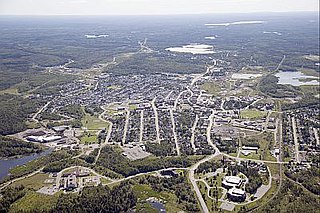
Kirkland Lake is a town and municipality in Timiskaming District of Northeastern Ontario. The 2021 population, according to Statistics Canada, was 7,750.

Larder Lake is an incorporated municipal township and eponymous constituent dispersed rural community in Timiskaming District in Northeastern Ontario, Canada. It is located along Ontario Highway 66 and Ontario Highway 624 at the north-western part of the lake bearing the same name. The area of the township is 229.65 km2 (88.67 sq mi) and includes the geographic townships of Hearst, McVittie and Skead.

Greenstone is a single-tier municipality in the Canadian province of Ontario with a population of 4,636 according to the 2016 Canadian census. It stretches along Highway 11 from Lake Nipigon to Longlac and covers 2,767.19 km2 (1,068.42 sq mi).
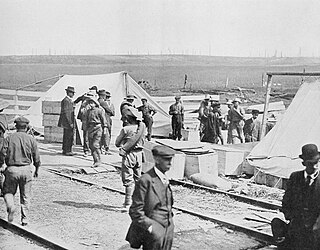
The great Matheson Fire was a deadly forest fire that passed through the region surrounding the communities of Black River-Matheson and Iroquois Falls, Ontario, Canada, on July 29, 1916.
William Henry Wright was a Canadian prospector.

SS Noronic was a Canadian passenger ship that was destroyed by fire in Toronto Harbour in September 1949 with the loss of at least 118 lives.

The Hollinger Gold Mine was discovered on October 9, 1909, by Benny Hollinger, who found the gold-bearing quartz dike that later became known as Hollinger Mines. With his friend, professional prospector Alex Gillies, Hollinger had travelled to the Porcupine region in the wake of the Wilson expedition, which had recently discovered the future Dome Mine site. Hollinger and Gillies staked three claims each, and one for their former partner, Bernard "Barney" P. McEnaney, who had been unable to join them due to severe sciatica.
The Hull-Ottawa fire of 1900 was a devastating fire in 1900 that destroyed much of Hull, Quebec, and large portions of Ottawa, Ontario.
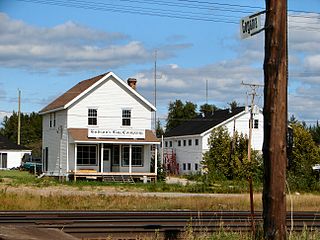
Gogama is a Northeastern Ontario community that is situated on Lake Minisinakwa, 580 kilometres north of Toronto, 191 km north of Sudbury, and 114 km south of Timmins. In the Canada 2011 Census, a population of 277 people was recorded. The community is counted as part of Sudbury, Unorganized, North Part in Canadian census data. It is not an incorporated municipality, but is administered by a local services board.

Temagami, formerly spelled Timagami, is a municipality in northeastern Ontario, Canada, in the Nipissing District with Lake Temagami at its heart.
The 1825 Miramichi Fire, or Great Miramichi Fire, or Great Fire of Miramichi, as it came to be known, was a massive forest fire complex that devastated forests and communities throughout much of northern New Brunswick in October 1825. It ranks among the three largest forest fires ever recorded in North America.

The Porcupine Gold Rush was a gold rush that took place in Northern Ontario starting in 1909 and developing fully by 1911. A combination of the hard rock of the Canadian Shield and the rapid capitalization of mining meant that smaller companies and single-man operations could not effectively mine the area, as opposed to earlier rushes where the gold could be extracted through placer mining techniques. Although a number of prospectors made their fortune, operations in the area are marked largely by the development of larger mining companies, and most people involved in the mining operations were their employees.
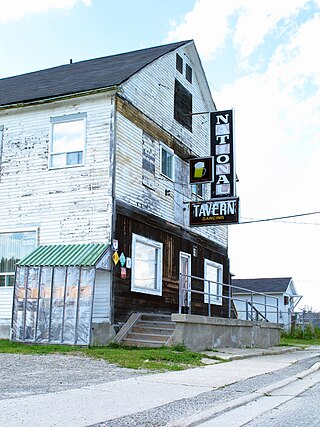
Val Gagné is an unincorporated rural community in the township of Black River-Matheson, Cochrane District, Ontario, Canada. It is located 1.5 km (0.93 mi) east of Highway 11, between Matheson and Iroquois Falls. For many years the community was accessible by train. The Ontario Northland Railway's Northlander from Toronto to Cochrane, which passed through Val Gagné, made its final passenger run in 2012. An Ontario Northland bus now stops at Val Gagné.
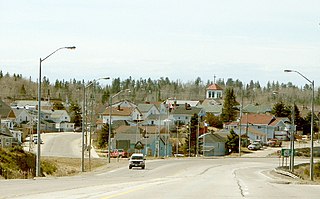
The city of Timmins, Ontario, Canada contains many named neighbourhoods. Some former municipalities that were merged into Timmins continue to be treated as distinct postal and telephone exchanges from the city core.
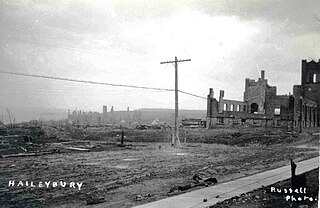
The Great Fire of 1922 was a wildfire burning through the Lesser Clay Belt in the Timiskaming District, Ontario, Canada, from October 4 to 5, 1922. It has been called one of the ten worst natural disasters in Canadian history.

The Porcupine River is a river in the James Bay and Moose River drainage basins in the city of Timmins, Cochrane District in northeastern Ontario, Canada. It flows 32 kilometres (20 mi) from Porcupine Lake to its mouth at Night Hawk Lake, the source of the Frederick House River, a tributary of the Abitibi River.

The Great Fire of 1852 was a fire in Montreal that began on July 8, 1852, and left as many as 10,000 people homeless and destroyed almost half of the city's housing. The fire occurred at a time when the city's recently constructed reservoir, located at the site of today's Saint-Louis Square, was drained and closed for repairs. The first fire broke out at a tavern on St. Lawrence Boulevard and spread quickly, fanned by strong winds and hot, dry summer weather.

















